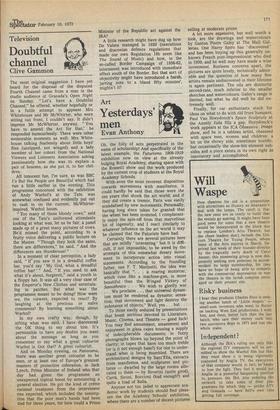Art
Yesterdays' men
Evan Anthony
Oh, the folly of acts perpetrated in the name of scholarship! And specifically of the latest example, the Futurismo 1909-1919 exhibition now on view at the already bulging Royal Academy, sharing space with the Rossetti show and the work produced by the current crop of students at the Royal Academy Schools.
With-even the most reverent disposition towards movements with manifestos, it could hardly be said that those were the ten years that shook the art world; and if they did create a tremor, Paris was easily scandalised by new movements. Personally, having long since taken for granted that the wheel has been invented, I complacently enjoy the spin-off from that marvellous bit of ingenuity, and I react similarly to whatever influence on the art world it may be claimed that the Futurists have had.
Certainly there are several pictures here that are mildly ' interesting ' but it is difficult, if not impossible, to be awed by the attempts of this somewhat dreary movement to incorporate action into visual statements. According to the founding father, one F. T. Marinetti, the idea was basically that ". . . a roaring motorcar, which runs like a machine-gun, is more beautiful than the Winged Victory of Samothrace . . . We wish to glorify war . . We proclaim. . . that universal dynamism must be rendered as dynamic sensa tion; that movement and light destroy the substance of objects." Well, yes . . . but . . . To those easily seduced by presentations that boast sections devoted to Literature, Music, Cinema, and Theatre — good luck!
You may find amusement, amazement and enjoyment in glass cases housing a supply of indecipherable documents; in fuzzy photographs blown up beyond the point of clarity; in tapes that have too much treble (or is it not enough base?) for one to under stand what is being mumbled. There are architectural designs by Sant'Elia, extracts from manifestos, and sculptures and pic tures — dwarfed by the large rooms allocated to them — by Severini (quite good), Cerra, Sironi, Boccioni (had enough?) and quite a load of Balla.
Anyone not too jaded to appreciate academic work by students should find pleas ure the the Academy Schools' exhibition, where there are a number of decent pictures selling at moderate prices.
A bit more expensive, but well worth a look, are the drawings and watercolours by Gaston Pierre Galey at The Mall Galleries. One Harry Spiro has ' discovered ' and has been buying up this generally unknown French post-Impressionist who died in 1959, and he well may have made a wise investment. Business concerns apart, the pictures are quite lovely, technically admirable and the question of how many fine artists remain undiscovered in their lifetime is again pertinent. The oils are distinctly second-rate, much inferior to the smaller sketches and watercolours. Galey's range is limited, but what he did well he did extremely well.
Finally, for car enthusiasts stuck for ideas on what to do with old front bumpers, Paul Van Hoeydonck's Space Sculpture at the Annely Juda fills a gap. Hoeydonck's work ,appears at the ICA Obsessive: Image show, and he is a tableau artist, obsessed with space men, women and children: a bit on the showy side, sometimes horrific, but occasionally the show-biz element subsides and a piece exists in its own right as innovatory and accomplished.


































 Previous page
Previous page